- 浏览: 22508212 次
- 性别:

- 来自: 杭州
-

最新评论
-
ZY199266:
配置文件还需要额外的配置ma
Android 客户端通过内置API(HttpClient) 访问 服务器(用Spring MVC 架构) 返回的json数据全过程 -
ZY199266:
我的一访问为什么是 /mavenwebdemo/WEB-I ...
Android 客户端通过内置API(HttpClient) 访问 服务器(用Spring MVC 架构) 返回的json数据全过程 -
lvgaga:
我又一个问题就是 如果像你的这种形式写。配置文件还需要额外的 ...
Android 客户端通过内置API(HttpClient) 访问 服务器(用Spring MVC 架构) 返回的json数据全过程 -
lvgaga:
我的一访问为什么是 /mavenwebdemo/WEB-I ...
Android 客户端通过内置API(HttpClient) 访问 服务器(用Spring MVC 架构) 返回的json数据全过程 -
y1210251848:
你的那个错误应该是项目所使用的目标框架不支持吧
log4net配置(web中使用log4net,把web.config放在单独的文件中)
Previous
Articles
New Features of WCF
4.0
: Part I
New Features of WCF 4.0
: Part
II
New Features of WCF 4.0
: Part III
Introduction
Microsoft.NET
4.0 and Visual Studio.NET 2010 ships a lot of new features in their
underlying technologies. In this series of articles, I want to talk
about the new features in the area of Windows Communication Foundation
(WCF) in order to improve the development experience, enable more
communication scenario, support new WS-* standards and provide a good
integration with Windows Workflow Foundation (WF).
The new
features are essentially the following: simplified configuration,
standard endpoints, IIS hosting without a SVC file, support for
WS-Discovery, routing service, REST improvements, enhancements for the
integration with WF to support workflow services, simple byte stream
encoding and ETW tracing.
In this series of article, I will
illustrate each feature explaining the principles and showing some
examples.
REST improvements
WCF ships a lot of
improvements for the development of Web services using REST approach.
These features can be accessed using the WebHttpBinding binding. Many of
these features were introduced in the WCF Rest Starter Kit and now they
are part of Microsoft.NET framework.
Automatic help page. This is a
nice feature because REST Web services have a lack of description
mechanisms to provide the metadata associated with the service. When you
host a service using WebServiceHost in WCF 4, a help page is generated
automatically. This is done using the WebHttpBinding and WebHttpBehavior
configuration by default in an environment defined by a WebServiceHost
instance. The WebHttpBehavior comes with a HelpEnabled property to
enable or disable the help page feature.
Let's apply this
principle to the EchoService developed in previous articles. Let's
create a console application to host our REST service.
Now let's
add the references to the WCF libraries needed to build the solution. We
need to add the System.ServiceModel.dll and System.ServiceModel.Web.dll
assemblies (see Figure 1).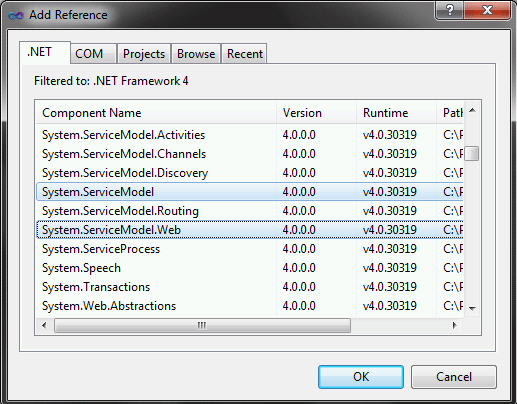
Figure 1
If
you don't see the System.ServiceModel.Web.dll assembly from the Add
Reference dialog box, you have to right-click on the console application
project and select the Properties option from the context menu. When
the Properties page appears, from the Application tab go to the Target
frameworks field and change to the .NET Framework 4 option (see Figure
2).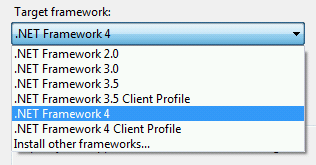
Figure 2
Next
step is to define the service contract. We're going to use the WCF
artifacts and extensions to REST Web services. In this case, we're going
to call the EchoService using traditional HTTP Get and HTTP Post
methods (two operations for each HTTP method) and the messages will be
encapsulated using plain old HTTP ways (see the Listing 1).
using
System;
using
System.Collections.Generic;
using
System.Linq;
using
System.Runtime.Serialization;
using
System.Text;
using
System.ServiceModel;
using
System.ServiceModel.Web;
namespace
WCF_NewFeatures
{
[ServiceContract
]
public
interface
IEchoService
{
[OperationContract
]
[WebGet
]
string
EchoGetMethod(String
message);
[OperationContract
]
[WebInvoke
]
string
EchoPostMethod(String
message);
}
}
Listing 1
Next
step is to realize the contract with a concrete service (see the
Listing 2). In this case, the outgoing messages of the service will be
in plain format, although we can use different format for the message
such as XML, Json, etc.
using
System;
using
System.Collections.Generic;
using
System.Linq;
using
System.Runtime.Serialization;
using
System.ServiceModel;
using
System.Text;
namespace
WCF_NewFeatures
{
public
class
EchoService
: IEchoService
{
#region
IEchoService Members
public
string
EchoGetMethod(string
message)
{
return
"EchoGetMethod invoked using HTTP Get method. Message is "
+
message;
}
public
string
EchoPostMethod(string
message)
{
return
"EchoGetMethod invoked using HTTP Post method.
Message is "
+ message;
}
#endregion
}
}
Listing 2
Next
step is to define the WCF artifacts in order to host the service in the
console application (see Listing 3).
using
System;
using
System.Collections.Generic;
using
System.Linq;
using
System.Text;
using
System.ServiceModel;
using
System.ServiceModel.Description;
using
System.ServiceModel.Web;
namespace
WCF_NewFeatures
{
class
Program
{
static
void
Main(string
[] args)
{
WebServiceHost
serviceHost = new
WebServiceHost
(typeof
(WCF_NewFeatures.EchoService
),new
Uri
("http://localhost:8080/Services/EchoService"
));
serviceHost.Open();
System.Console
.WriteLine("The EchoService has started"
);
foreach
(ServiceEndpoint
se in
serviceHost.Description.Endpoints)
{
System.Console
.WriteLine("Address:{0}, Binding:{1},
Contract:{2}"
, se.Address, se.Binding.Name, se.Contract.Name);
}
System.Console
.WriteLine("Please, press any key to finish ..."
);
System.Console
.ReadLine();
serviceHost.Close();
}
}
}
Listing 3
When
you configure a WebServiceHost instance to host a service, it
automatically configures your service with the WebHttpBehavior and adds a
default HTTP endpoint configured with the WebHttpBinding at the base
address. The only thing to do is to set the HelpEnabled property to true
of the WebHttpBehavior (see Listing 4).
<?
xml
version
=
"1.0
"
?>
<
configuration
>
<
system.serviceModel
>
<
serviceHostingEnvironment
aspNetCompatibilityEnabled
=
"true
"
/>
<
services
>
<
service
name
=
"WCF_NewFeatures.EchoService
"
>
<
endpoint
address
=
""
behaviorConfiguration
=
"WCF_NewFeatures.EchoServiceBehavior
"
binding
=
"webHttpBinding
"
contract
=
"WCF_NewFeatures.IEchoService
"
>
</
endpoint
>
</
service
>
</
services
>
<
behaviors
>
<
endpointBehaviors
>
<
behavior
name
=
"WCF_NewFeatures.EchoServiceBehavior
"
>
<
webHttp
helpEnabled
=
"true
"
/>
</
behavior
>
</
endpointBehaviors
>
</
behaviors
>
</
system.serviceModel
>
<
startup
><
supportedRuntime
version
=
"v4.0
"
sku
=
".NETFramework,Version=v4.0
"/></
startup
></
configuration
>
Listing 4
Now you can see the
help page by browsing to the service's base address and appending the
help string to the end of the url (see Listing 4).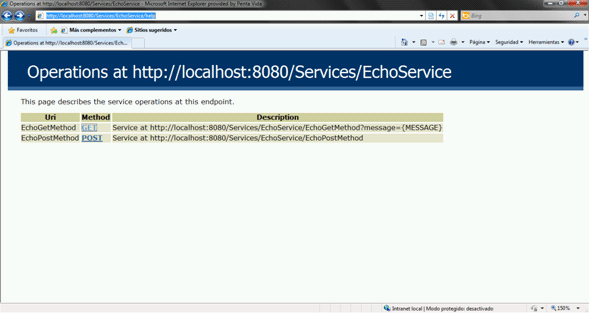
Figure 3
If
you see the help page, you realize that you can test the EchoGetMethod
operation of the service by sending a request using HTTP GET method and
passing information in the message parameter. This can be easily done
using the browser and the following url
http://localhost:8080/Services/EchoService/EchoGetMethod?message=test
and see the result in the Figure 4.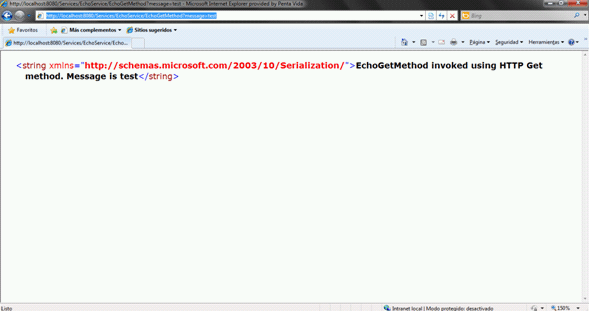
Figure 4
Let's
see how you can configure the Help Page feature using code without the
need of the configuration file (see Listing 5).
using
System;
using
System.Collections.Generic;
using
System.Linq;
using
System.Text;
using
System.ServiceModel;
using
System.ServiceModel.Description;
using
System.ServiceModel.Web;
namespace
WCF_NewFeatures
{
class
Program
{
static
void
Main(string
[] args)
{
WebServiceHost
serviceHost = new
WebServiceHost
(typeof
(WCF_NewFeatures.EchoService
),new
Uri
("http://localhost:8080/Services/EchoService"
));
serviceHost.AddServiceEndpoint(typeof
(WCF_NewFeatures.IEchoService
), new
WebHttpBinding
(),""
);
serviceHost.Description.Endpoints[0].Behaviors.Add(new
WebHttpBehavior
{ HelpEnabled = true
});
serviceHost.Open();
System.Console
.WriteLine("The EchoService has started"
);
foreach
(ServiceEndpoint
se in
serviceHost.Description.Endpoints)
{
System.Console
.WriteLine("Address:{0}, Binding:{1},
Contract:{2}"
, se.Address, se.Binding.Name, se.Contract.Name);
}
System.Console
.WriteLine("Please, press any key to finish ..."
);
System.Console
.ReadLine();
serviceHost.Close();
}
}
}
Listing 5
You
can control the REST binding such as message formats and uri template
(to apply to REST uri style) using the properties of the WebGet and
WebInvoke attribute (see Table 1).
Property Name
Type
Possible Value
Description
BodyStyle
WebMessageBodyStyle
Bare
Wrapped
WrappedRequest
WrappedResponse
Controls the aspects of the message envelop.
RequestFormat
WebMessageFormat
Json
XML
Specifies the message format for the
request
ResponseFormat
WebMessageFormat
Json
XML
Specifies the message format for the
response
UriTemplate
String
Any string
representing a valid
uri
The template that matches against the
incoming request
Table 1
Let
me demonstrate how to describe the shape of the URIs to which the
EchoService will respond. For example, let's change the request URI for
the service by adding the following pattern GetEcho/{message} for the
GET method, and PostEcho/{message} for the POST method where the message
is the parameter. Now you can access to the service and pass the
parameters in this way,
http://localhost:8080/Services/EchoService/getecho/mymessage (see Figure
5).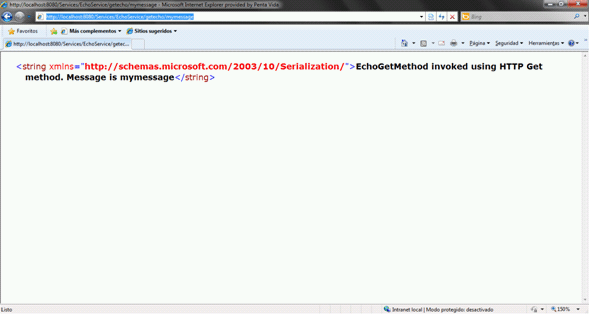
Figure 5
Let
me demonstrate how to support different message format, for example, XML
and Json. Now, we're going to change the interface to expose two
operations for processing messages coming using HTTP Get method and
sending the response either by XML or Json depending on the request URI
as shown in the previous example (see Listing 6).
using
System;
using
System.Collections.Generic;
using
System.Linq;
using
System.Runtime.Serialization;
using
System.Text;
using
System.ServiceModel;
using
System.ServiceModel.Web;
namespace
WCF_NewFeatures
{
[ServiceContract
]
public
interface
IEchoService
{
[OperationContract
]
[WebGet
(UriTemplate="GetEcho/json/{message}"
,
ResponseFormat=WebMessageFormat
.Json)]
string
EchoGetMethodJson(String
message);
[OperationContract
]
[WebGet
(UriTemplate = "GetEcho/xml/{message}"
,
ResponseFormat = WebMessageFormat
.Xml)]
string
EchoGetMethodXml(String
message);
[OperationContract
]
[WebInvoke
(UriTemplate =
"PostEcho/{message}"
)]
string
EchoPostMethod(String
message);
}
}
Listing 6
And
the implementation of the contract is shown in the service of the
Listing 7.
using
System;
using
System.Collections.Generic;
using
System.Linq;
using
System.Runtime.Serialization;
using
System.ServiceModel;
using
System.Text;
namespace
WCF_NewFeatures
{
public
class
EchoService
: IEchoService
{
#region
IEchoService Members
public
string
EchoGetMethodJson(string
message)
{
return
"EchoGetMethodJson invoked using HTTP Get method. Message is (Json
format) "
+ message;
}
public
string
EchoGetMethodXml(string
message)
{
return
"EchoGetMethodXml invoked using HTTP Get method. Message is (Xml
format) "
+ message;
}
public
string
EchoPostMethod(string
message)
{
return
"EchoGetMethod invoked
using HTTP Post method.
Message is "
+ message;
}
#endregion
}
}
Listing 7
Going to
the Help Page for the service, you will find the description of the
service and the way to access to this (see Figure 6).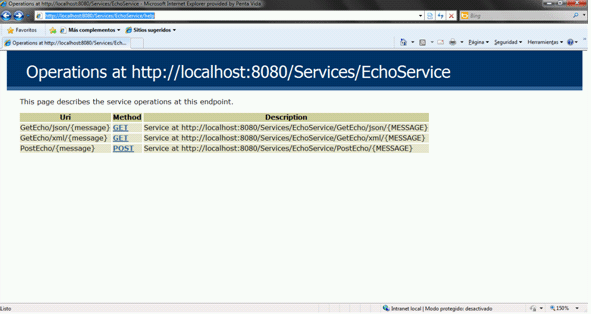
Figure 6
So,
you can access to the service using the HTTP Get method and receiving
the response formatted using Json by the following URI http://localhost:8080/Services/EchoService/getecho/json/mymessage
.
In WCF 4.0 you can also access to the request and message
format at runtime. Let's create a generic getecho operation passing as
parameter the format of the outgoing message and processing this
information at runtime.
Let's redefine the service contract again
as shown in the Listing 8.
using
System;
using
System.Collections.Generic;
using
System.Linq;
using
System.Runtime.Serialization;
using
System.Text;
using
System.ServiceModel;
using
System.ServiceModel.Web;
namespace
WCF_NewFeatures
{
[ServiceContract
]
public
interface
IEchoService
{
[OperationContract
]
[WebGet
(UriTemplate="GetEcho/{message}"
)]
string
EchoGetMethod(String
message);
[OperationContract
]
[WebInvoke
(UriTemplate =
"PostEcho/{message}"
)]
string
EchoPostMethod(String
message);
}
}
Listing 8
And
the implementation of the contract is shown in the Listing 9.
using
System;
using
System.Collections.Generic;
using
System.Linq;
using
System.Runtime.Serialization;
using
System.ServiceModel;
using
System.ServiceModel.Web;
using
System.Text;
namespace
WCF_NewFeatures
{
public
class
EchoService
: IEchoService
{
#region
IEchoService Members
public
string
EchoGetMethod(string
message)
{
string
outgoingMessageFormat = WebOperationContext
.Current.IncomingRequest.UriTemplateMatch.QueryParameters["format"
];
if
(!String
.IsNullOrEmpty(outgoingMessageFormat))
{
if
(outgoingMessageFormat.Equals("json"
,StringComparison
.OrdinalIgnoreCase))
{
WebOperationContext
.Current.OutgoingResponse.Format
= WebMessageFormat
.Json;
}
else
if
(outgoingMessageFormat.Equals("xml"
, StringComparison
.OrdinalIgnoreCase))
{
WebOperationContext
.Current.OutgoingResponse.Format
= WebMessageFormat
.Xml;
}
}
return
"EchoGetMethodJson invoked using
HTTP Get method. Message is (Json format) "
+ message;
}
public
string
EchoPostMethod(string
message)
{
return
"EchoGetMethod invoked using HTTP Post method.
Message is "
+ message;
}
#endregion
}
}
Listing 9
Now
if you access to the service using the following URI
http://localhost:8080/Services/EchoService/getecho/mymessage?format=xml,
you will receive a the response in XML format, and if you request the
service using the following URI
http://localhost:8080/Services/EchoService/getecho/mymessage?format=json,
you will receive the response in Json format.
Another good
feature of WCF 4.0 to support REST Web services is the error handling
support in order to build more robust applications and avoid
constructing manually the HTTP response with error message.
Now
we can use a new class for error handling: WebFaultException<T>.
For example, if you want to include error handling in the previous
example in order to report an unsupported format, you need to include
the code shown in the Listing 10 highlighted in yellow.
using
System;
using
System.Collections.Generic;
using
System.Linq;
using
System.Runtime.Serialization;
using
System.ServiceModel;
using
System.ServiceModel.Web;
using
System.Text;
using
System.Net;
namespace
WCF_NewFeatures
{
public
class
EchoService
: IEchoService
{
#region
IEchoService Members
public
string
EchoGetMethod(string
message)
{
string
outgoingMessageFormat = WebOperationContext
.Current.IncomingRequest.UriTemplateMatch.QueryParameters["format"
];
if
(!String
.IsNullOrEmpty(outgoingMessageFormat))
{
if
(outgoingMessageFormat.Equals("json"
,StringComparison
.OrdinalIgnoreCase))
{
WebOperationContext
.Current.OutgoingResponse.Format
= WebMessageFormat
.Json;
}
else
if
(outgoingMessageFormat.Equals("xml"
,
StringComparison
.OrdinalIgnoreCase))
{
WebOperationContext
.Current.OutgoingResponse.Format
= WebMessageFormat
.Xml;
}
else
{
throw
new
WebFaultException
<string
>("Unsupported format "
+ outgoingMessageFormat, HttpStatusCode
.BadRequest);
}
}
return
"EchoGetMethodJson
invoked using HTTP Get method.
Message is (Json format) "
+ message;
}
public
string
EchoPostMethod(string
message)
{
return
"EchoGetMethod invoked using HTTP Post method.
Message is "
+ message;
}
#endregion
}
}
Listing 10
Another
good feature in WCF to support REST Web services is the HTTP Caching.
WCF comes with a simple model to implement caching through the
[AspNetCacheProfile] attribute that you can apply to operations
supported by HTTP Get method. This attribute enables specifying an
ASP.NET caching profile name for each operation and behind the scenes
there's a cache inspector taking care of the handling of the underlying
caching implementation.
Conclusion
In this series
of article, I've explained the new features of WCF 4.0 through concepts
and examples.
Next Articles
New Features of WCF 4.0
: Part V







相关推荐
根据提供的文件信息,我们可以归纳出一系列与WCF 4.0相关的专业知识点。这份教材主要围绕Windows Communication Foundation (WCF) 4.0展开,详细介绍了如何利用.NET 4进行服务开发、部署和服务交互等内容。下面我们...
### WCF 4.0 多层服务开发与 LINQ to Entities #### 一、WCF 4.0 概述 Windows Communication Foundation (WCF) 是 Microsoft 提供的一个用于构建服务导向架构(SOA)应用程序的框架。WCF 4.0 作为 .NET Framework...
Packtpub WCF 4.0 Multi tier Services Development with LINQ to Entities Jun.2010 关于WCF 4.0 和LINQ to Entity 的 新书 流行加时尚的编程利器
在技术层面,本书涵盖了WCF 4.0的核心部分,包括服务模型、宿主模型、绑定、消息交换模式、元数据发布、安全性、事务处理、消息路由、可靠性以及宿主和部署等。这些内容帮助读者构建和维护WCF服务,以及了解如何在...
一个非常简单的WCF例子:Hello World 本解决方案有3个项目: 1、WCFClient:客户端,展示通过wcf后得到的结果,一个小的winform; 2、WCFContrlPanel:主控程序,作为打开/关闭wcf服务的控制面板,winform; 3、...
6. **服务质量**:WCF提供服务质量管理,包括服务质量QoS(Quality of Service),如消息队列、负载均衡和故障恢复,确保服务的高效稳定运行。 7. **服务发现**:WCF有内置的服务发现机制,使得服务可以在网络中被...
【标题】"我的第一个WCF程序:HelloInDigo"是一个初学者的实践项目,它展示了如何使用Windows Communication Foundation(WCF)技术创建一个简单的服务。WCF是.NET框架的一部分,用于构建分布式、面向服务的应用程序...
**创建一个简单的WCF程序:WcfServices与WcfServices2** Windows Communication Foundation(WCF)是.NET Framework中用于构建分布式应用程序的一种强大的服务导向架构。它允许开发人员创建跨平台的、安全的、可靠...
WCF全面解析:上册.part3.rar
标题中的“Packtpub.WCF.4.0.Multi.tier.Services.Development.with.LINQ.to.Entities.Jun.2010”暗示了这是一份关于使用Windows Communication Foundation(WCF)4.0开发多层服务的教程,其中特别强调了使用LINQ to...
Windows Communication Foundation (WCF) 是微软推出的一种用于构建分布式应用程序的框架,它集成了多种通信技术,为开发者提供了一种统一的方式来创建、发布和消费服务。WCF是.NET Framework 3.0及更高版本的一部分...
WCF全面解析:上册.part2.rar
**WCF技术专题:WCF入门与进阶** Windows Communication Foundation(WCF)是微软推出的一种面向服务的架构,用于构建可互操作的分布式应用程序。它整合了.NET框架中的多种通信技术,如ASMX、Remoting、Web ...
《Wrox Professional WCF 4: Windows Communication Foundation with .NET 4》这本书是关于Windows Communication Foundation(WCF)技术的权威指南,专为.NET Framework 4.0设计。WCF是微软提供的一种全面的、统一...